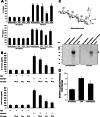The immunologically active oligosaccharides isolated from wheatgrass modulate monocytes via Toll-like receptor-2 signaling
- PMID: 23629653
- PMCID: PMC3682569
- DOI: 10.1074/jbc.M112.448381
The immunologically active oligosaccharides isolated from wheatgrass modulate monocytes via Toll-like receptor-2 signaling
Erratum in
-
The immunologically active oligosaccharides isolated from wheatgrass modulate monocytes via Toll-like receptor-2 signaling.J Biol Chem. 2015 May 8;290(19):11935. doi: 10.1074/jbc.A112.448381. J Biol Chem. 2015. PMID: 25957413 Free PMC article. No abstract available.
Abstract
Wheatgrass is one of the most widely used health foods, but its functional components and mechanisms remain unexplored. Herein, wheatgrass-derived oligosaccharides (WG-PS3) were isolated and found to induce CD69 and Th1 cytokine expression in human peripheral blood mononuclear cells. In particular, WG-PS3 directly activated the purified monocytes by inducing the expression of CD69, CD80, CD86, IL-12, and TNF-α but affected NK and T cells only in the presence of monocytes. After further purification and structural analysis, maltoheptaose was identified from WG-PS3 as an immunomodulator. Maltoheptaose activated monocytes via Toll-like receptor 2 (TLR-2) signaling, as discovered by pretreatment of blocking antibodies against Toll-like receptors (TLRs) and also determined by click chemistry. This study is the first to reveal the immunostimulatory component of wheatgrass with well defined molecular structures and mechanisms.
Keywords: Carbohydrate Function; Immune Activation; Maltoheptaose; Monocytes; Natural Products; Oligosaccharide; Toll-like Receptors (TLR); Wheatgrass.
Figures







Similar articles
-
Microglia Induce Neurotoxic IL-17+ γδ T Cells Dependent on TLR2, TLR4, and TLR9 Activation.PLoS One. 2015 Aug 19;10(8):e0135898. doi: 10.1371/journal.pone.0135898. eCollection 2015. PLoS One. 2015. PMID: 26288016 Free PMC article.
-
Surfactant protein D induces immune quiescence and apoptosis of mitogen-activated peripheral blood mononuclear cells.Immunobiology. 2016 Feb;221(2):310-22. doi: 10.1016/j.imbio.2015.10.004. Epub 2015 Oct 28. Immunobiology. 2016. PMID: 26563748
-
The mycelium of the Trametes versicolor (Turkey tail) mushroom and its fermented substrate each show potent and complementary immune activating properties in vitro.BMC Complement Altern Med. 2019 Dec 2;19(1):342. doi: 10.1186/s12906-019-2681-7. BMC Complement Altern Med. 2019. PMID: 31791317 Free PMC article.
-
Enzyme Hydrolysates of Ginseng Marc Polysaccharides Promote the Phagocytic Activity of Macrophages Via Activation of TLR2 and Mer Tyrosine Kinase.J Microbiol Biotechnol. 2018 Jun 28;28(6):860-873. doi: 10.4014/jmb.1801.01003. J Microbiol Biotechnol. 2018. PMID: 29642293
-
Distinct responses of monocytes to Toll-like receptor ligands and inflammatory cytokines.Int Immunol. 2004 Jun;16(6):799-809. doi: 10.1093/intimm/dxh083. Epub 2004 Apr 19. Int Immunol. 2004. PMID: 15096475
Cited by
-
Non-Digestible Oligosaccharides: A Novel Treatment for Respiratory Infections?Nutrients. 2022 Nov 26;14(23):5033. doi: 10.3390/nu14235033. Nutrients. 2022. PMID: 36501062 Free PMC article. Review.
-
Antioxidant, Immunostimulatory, and Anticancer Properties of Hydrolyzed Wheat Bran Mediated through Macrophages Stimulation.Int J Mol Sci. 2023 Apr 18;24(8):7436. doi: 10.3390/ijms24087436. Int J Mol Sci. 2023. PMID: 37108599 Free PMC article.
-
Elemental and macromolecular modifications in Triticum aestivum L. plantlets under different cultivation conditions.PLoS One. 2018 Aug 28;13(8):e0202441. doi: 10.1371/journal.pone.0202441. eCollection 2018. PLoS One. 2018. PMID: 30153262 Free PMC article.
-
Preventive Effects and Mechanisms of Garlic on Dyslipidemia and Gut Microbiome Dysbiosis.Nutrients. 2019 May 29;11(6):1225. doi: 10.3390/nu11061225. Nutrients. 2019. PMID: 31146458 Free PMC article.
-
Modulation of Toll-like receptor signaling in innate immunity by natural products.Int Immunopharmacol. 2016 Aug;37:65-70. doi: 10.1016/j.intimp.2016.02.005. Epub 2016 Feb 15. Int Immunopharmacol. 2016. PMID: 26899347 Free PMC article. Review.
References
-
- Alitheen N. B., Oon C. L., Keong Y. S., Chuan T. K., Li H. K., Yong H. W. (2011) Cytotoxic effects of commercial wheatgrass and fiber towards human acute promyelocytic leukemia cells (HL60). Pak. J. Pharm. Sci. 24, 243–250 - PubMed
-
- Das A., Raychaudhuri U., Chakraborty R. (2012) Effect of freeze drying and oven drying on antioxidant properties of fresh wheatgrass. Int. J. Food Sci. Nutr. 63, 718–721 - PubMed
-
- Ben-Arye E., Goldin E., Wengrower D., Stamper A., Kohn R., Berry E. (2002) Wheat grass juice in the treatment of active distal ulcerative colitis. A randomized double-blind placebo-controlled trial. Scand. J. Gastroenterol. 37, 444–449 - PubMed
-
- Shermer M. (2008) Wheatgrass juice and folk medicine. Sci. Am. 299, 42 - PubMed
-
- Chang R. (2002) Bioactive polysaccharides from traditional Chinese medicine herbs as anticancer adjuvants. J. Altern. Complement. Med. 8, 559–565 - PubMed
Publication types
MeSH terms
Substances
LinkOut - more resources
Full Text Sources
Other Literature Sources

